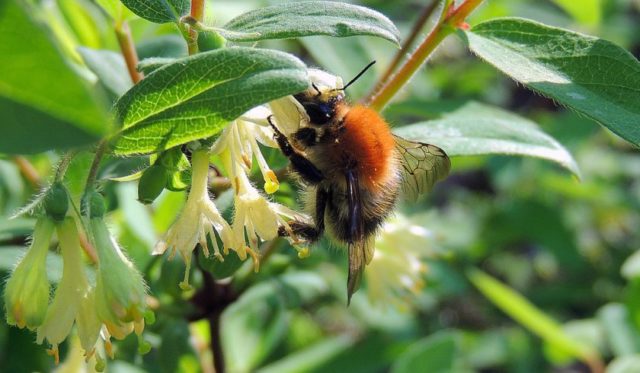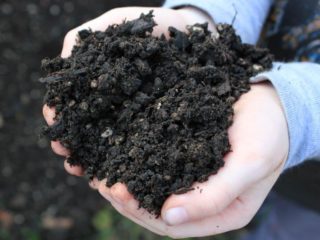Content
Honeysuckle, which has long settled in the plots of residents of regions with cool climates, is gradually conquering southern gardens. But the crop feels uncomfortable there, bears fruit poorly, and the bush and berries do not reach the size indicated in the description of the variety. One of the factors that can improve the situation is the comfortable placement of the culture. The distance when planting honeysuckle is an issue that requires special consideration. The information will also be useful to northerners who want to make care easier and increase productivity.

Honeysuckle bushes should be placed at a sufficient distance from each other
Why is honeysuckle planted at a distance?
Proper planting of honeysuckle is the key to a future harvest. Sometimes southerners, believing that the northern berries do not receive enough sun in their homeland, place the plants close together, collect a handful of fruits each year and become disappointed in the crop. But they themselves are to blame.
When planting honeysuckle, the distance from each other between the bushes must be maintained for the following reasons:
- In one place, the crop grows and bears fruit for up to 30 years. It has good shoot-forming ability in cool climates.In warm weather, honeysuckle, although it does not grow to the size stated in the variety description, when it takes root, it quickly increases its green mass. When planted densely, the bushes thicken.
- Honeysuckle is pollinated by bees, bumblebees and wasps. Without the participation of insects, it will bloom and produce little fruit. The buds open very early, because the first berries appear 7-14 days before strawberries. And insects are not very active at this time; they work only in the sun. To attract them, flowers must be easily accessible and well lit. Otherwise, pollinators will pay attention to dandelions or other plants.
- Honeysuckle is a very healthy and tasty berry. But it can be sour if the fruits get little sunlight. If planted tightly, only the first berries will contain enough sugars. When the bush comes into full fruiting, due to the thickened planting, it will become bitter and sour. In addition, the size of the berries will decrease, and they are already small.
- Honeysuckle fruits are prone to shedding. Domestic and foreign breeders are struggling with this problem. With dense planting, part of the harvest will have to be collected from the ground, and in varieties prone to shedding, all of it.
- If the distance between the bushes is not maintained, care will become significantly more difficult.
- The main harvest on thickened plants is concentrated on branches exposed to the sun.
- When planted tightly, not only the shoots are intertwined, but also the roots. The feeding area decreases, which leads to slower growth and reduced yield.

Pollinating insects need to be provided with unhindered access to flowers; they open too early, bees and bumblebees are still lethargic
At what distance should honeysuckle bushes be planted?
There is no single scheme for how much distance should be left between bushes and rows of honeysuckle when planting.The varieties are different, so are the conditions. And although even in the specialized literature average figures are indicated - there is a gap of about 1.5-2 m between plants, rows every 2-2.5 m, other factors should be taken into account.
For example, the habit of a bush depending on the variety. There is no point in making a distance of 2x2.5 m and even 1.5x2 m between honeysuckle with erect branches, 1 m high. The place will walk, especially in warm areas, where this variety, at best and with good care, will reach 70-80 cm. On the other hand, for tall spreading bushes on slightly acidic soils in a cool climate, 2 m between plants may not be enough.
When planning the placement of a crop on a site, you should ensure that the bush:
- well lit from all sides;
- did not interfere with other plants;
- it should be easy to access for care and harvesting;
- was located in close proximity to other varieties (this is a cross-pollinated plant).
Advice from experienced gardeners
Honeysuckle is well known in the cool regions of Russia, but until a few decades ago it was rarely grown in gardens as a berry bush. It was believed that the fruits were too sour, with a bitter taste, and they were not easy to pick; before they had time to ripen, they had already begun to crumble.
The culture gained enormous popularity in North America and Europe, and only after that did Russian gardeners pay attention to it. It turns out that honeysuckle can be tasty. Large-fruited, non-shattering varieties are easy to harvest. The demand for the berry has increased so much that it rarely reaches regions where the crop is not grown.
Domestic berry producers lag behind Western ones; demand exceeds supply. But selection is carried out at the level. Several institutes and experimental stations are engaged in culture. Wonderful varieties of Bachkar and Leningrad honeysuckle have been bred, not inferior to foreign ones, but more adapted to Russian conditions.
Therefore, even for those who live in areas where honeysuckle grows, the advice of experienced gardeners may be useful:
- For normal fruiting, 2 varieties on the site are not enough. You need to plant at least 3.
- It is better to place honeysuckle not in rows, but in clumps.
- The maximum distance between bushes for normal pollination is 18-20 m, and not 40, like for fruit trees. And better - less. Hymenoptera - bees, wasps, bumblebees are not too active during honeysuckle flowering. It’s better not to expect that they will immediately fly from one bush to another, and not be distracted, for example, by a dandelion.
- If the plot is small, you can come to an agreement with your neighbors and plant berry fields nearby, but on opposite sides of the boundary.
- In a small area, honeysuckle can be placed in a flowerbed or in a landscape group - it is a beautiful, healthy plant. You just need to maintain a distance and not place it next to crops that require regular processing.

Only with the correct placement of honeysuckle bushes can you reap a good harvest
Conclusion
The distance when planting honeysuckle should be large enough to provide unobstructed access to the bush, feeding area and lighting. But you shouldn’t “scatter” them in different parts of the garden, so as not to interfere with pollination. This is the only way to achieve a good harvest.








